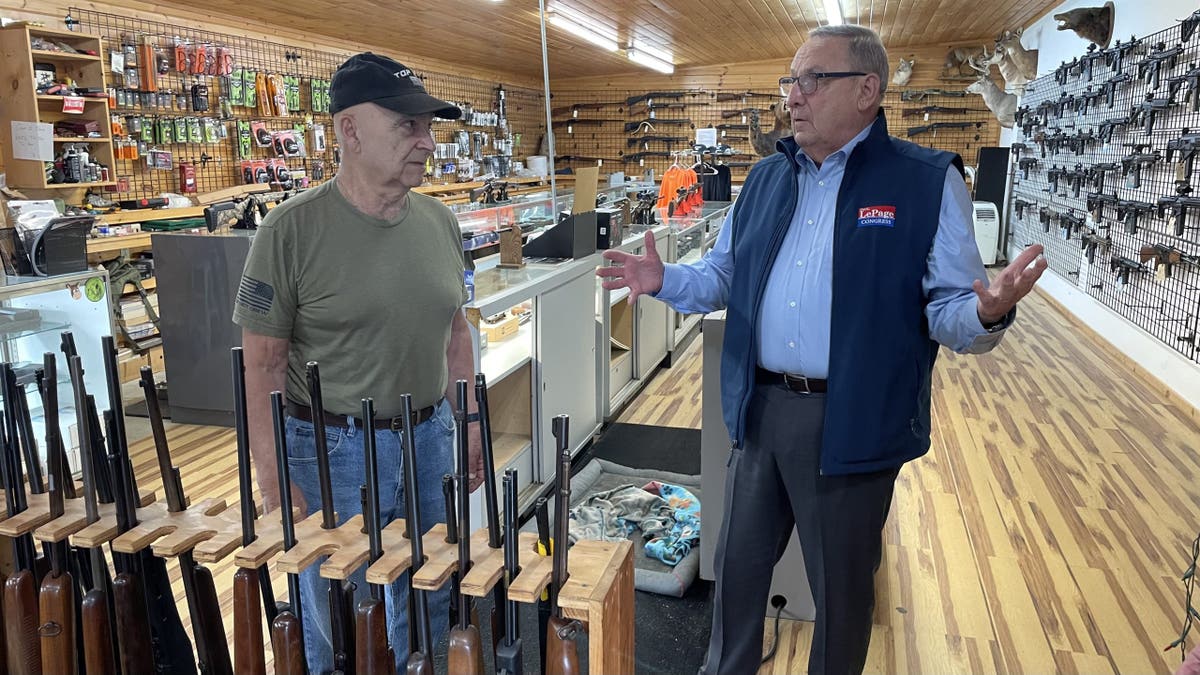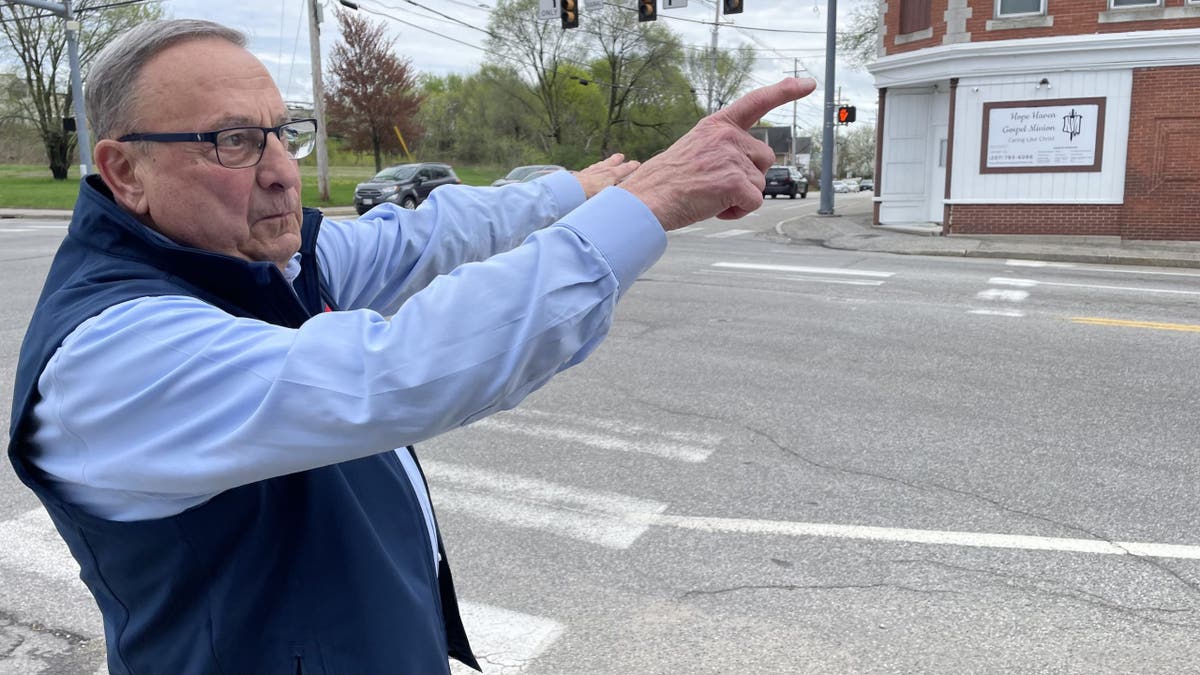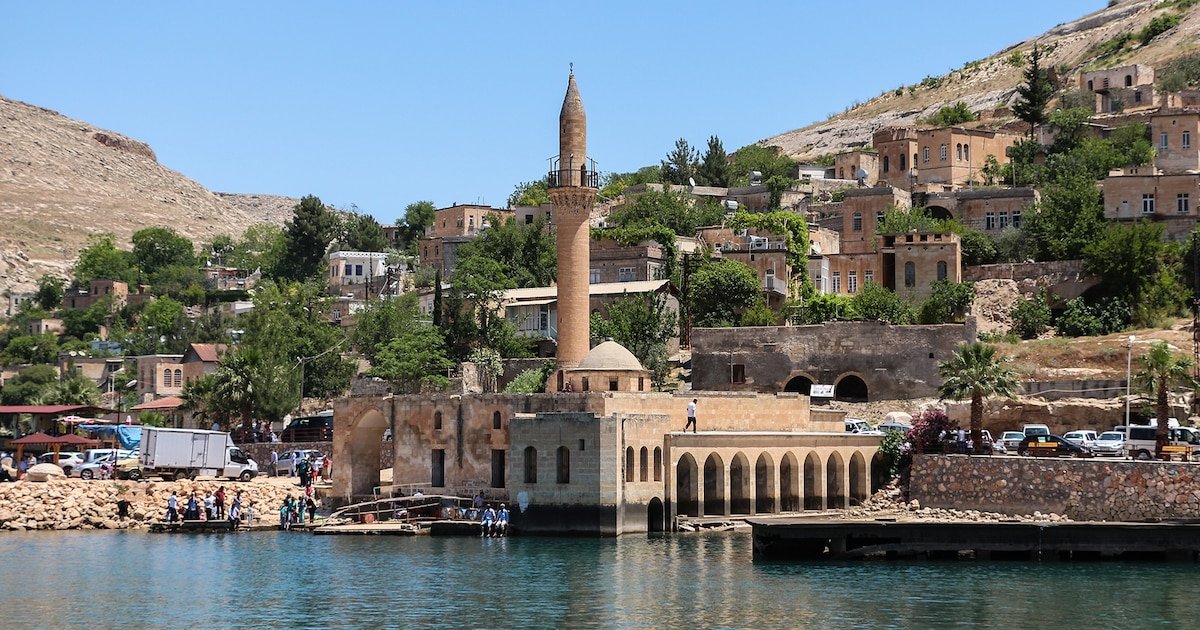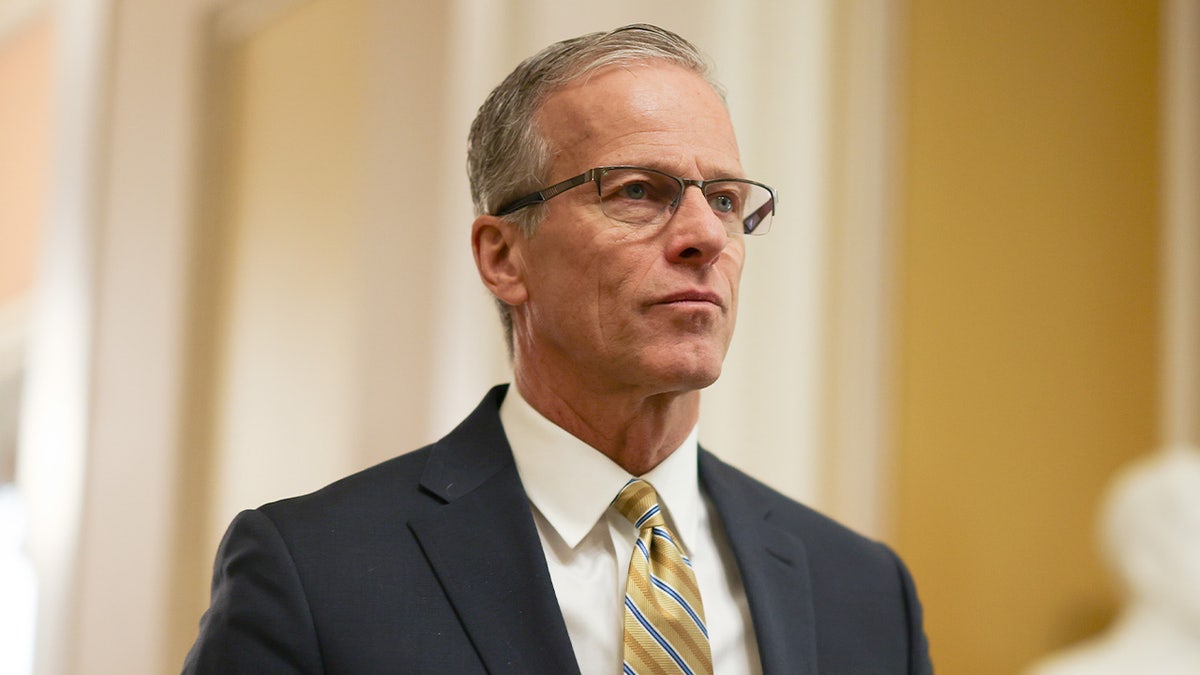INTERNACIONAL
Why longtime Trump ally and former Republican Gov. Paul LePage is aiming for a political comeback

LEWISTON, MAINE – EXCLUSIVE – Former two-term Gov. Paul LePage of Maine says President Donald Trump is a major reason why he’s coming out of political retirement at age 76 – and he’s eyeing a campaign comeback.
«I never, ever had any aspirations to go to Washington until now,» LePage said this week in his first national interview after launching his bid for the House in Maine’s Second Congressional District, which is a top swing seat the GOP aims to flip in the 2026 midterm elections.
The contest will likely be one of the most closely watched House races in the country next year as the Republicans aim to hold their fragile majority in the chamber.
«Donald Trump, I think, is doing what is necessary in addressing the debt this country is facing. And I think that’s a big, big thing for me,» LePage said as he was interviewed in the Maine city where he was born and raised.
HOUSE REPUBLICAN CAMPAIGN CHAIR SPELLS OUT HIS PLAYBOOK TO HOLD THE CONGRESSIONAL MAJORITY
Former Republican Gov. Paul LePage, who is running for the House in 2026 in Maine’s 2nd Congressional District, speaks with Fox News Digital in Lewiston, Maine, on May 7, 2025, in his first interview after announcing his candidacy. (Fox News – Paul Steinhauser)
LePage highlighted, «I have a friend in the White House right now. I know President Trump. I think I can have an audience of President Trump. I know several of his secretaries very well. And so I think this is a good time. It’s a good time for me to go help.»
LePage – the brash and blunt politician who won over blue-collar workers struggling with economic woes, which helped the Republican businessman win election and re-election in the blue-leaning state – was one of the first major GOP elected officials to endorse Trump when the president first ran for the White House nearly a decade ago.
«I was Donald Trump before Donald Trump became popular,» LePage joked at the time, in a line that’s since become famous.
The conservative governor, who grabbed national attention with controversial comments made during his tenure, briefly moved with his wife, Ann, to Florida after finishing his second term in 2019.
«I am done with politics. I have done my eight years. It’s time for somebody else,» he said at the time.
CONGRESSIONAL DEMOCRATS TARGETING THESE HOUSE REPUBLICANS IN 2026 MIDTERM BATTLE
But LePage re-established residency in Maine five years ago and challenged his successor as governor, Democratic Gov. Janet Mills, in the 2022 election.
LePage ended up losing his bid for a third term by 13 points to Mills, but he did carry the 2nd Congressional District in that race.
Moderate Democratic Rep. Jared Golden, a U.S. Marine veteran who deployed to the wars in Afghanistan and Iraq, and who often bucks his own party in Congress, has held the seat since first winning it in 2018.

Rep. Jared Golden, D-Maine, at a news conference in the U.S. Capitol on Wednesday, March 6, 2024, has represented Maine’s 2nd Congressional District since first winning the seat in 2018. (Bill Clark/CQ-Roll Call, Inc. via Getty Images)
But Golden won re-election by a razor-thin margin last year in the district, which is the second-most rural in the U.S. and the largest east of the Mississippi River.
And Trump, who carried the district in the 2016, 2020 and 2024 presidential elections by nine, seven and 10 points, earned an electoral vote each time, as Maine and Nebraska, are the only two states in the union to allocate their electoral votes partially by congressional district.
MAINE’S GOLDEN TAKES AIM AT FELLOW DEMOCRATS OVER POLICY
Golden, in a statement after LePage announced his candidacy, said, «I thought Paul was doing his best work in retirement.»
But the 42-year-old Golden has yet to announce whether he’ll seek re-election next year or instead run for either the state’s Senate seat or the open governor’s office.
In his Fox News interview, LePage reiterated that the nation’s debt is a top motivation for him to return to politics. As of May 8, the national debt was $36,212,886,111,158.26, according to Fox News’ National Debt Tracker.
«It’s the spending and the debt that this country has, and I’m worried about my grandchildren, great-grandchildren. And I think we have a president now that’s really willing to tackle it, and I’m willing to help,» he said.
But LePage added that «the other thing that is really big is what’s happening in our country with the woke environment. I think I want to be there to help clean that up if we can. Having boys play in girls’ sports is really sad.»
He also highlighted his Tuesday meeting—part of a three-day swing through the congressional district—with Maine student Cassidy Carlisle, whom he described as «the courageous young woman fighting unfair male competition in girls’ sports.»
Maine’s 2nd Congressional District shares a long border with Canada.
When asked if he’ll be spotlighting border security and immigration as major issues in his campaign, Lepage said, «Big time.»
But the controversial tariffs the president placed on nations across the globe last month has strained relations with Canada.

Former Maine Gov. Paul LePage, who’s running a Republican campaign for Congress in 2026, speaks to a voter at a gun shop and indoor firing range, on May 7, 2025, in Poland, Maine. (Fox News – Paul Steinhauser)
«I’m all for the tariffs,» LePage said. «The tariffs will fix our international trade and lower taxes.»
LePage acknowledged: «Is it going to hurt in the short term? Yeah, it’s going to hurt a little bit in the short term, but I think it’s necessary.»
And he predicted that «the tariffs are going to be a short-term problem. I think they’re going to settle out.»
LePage spoke with Fox News at Lewiston’s Franco Center, a performing arts center and historic site of Franco-American culture located in a former Gothic church built in 1907 for French Canadian immigrants in Maine, which is located alongside the city’s historical mills and canals.

Former Maine Gov. Paul LePage, who’s running a 2026 Republican campaign for Congress, tours the Franco Center, a performing arts center and historic site of Franco-American culture located in a former Gothic church in the city of Lewiston, on May 7, 2025. Lepage was baptized as a child in the church. (Fox News – Paul Steinhauser)
The former governor, who survived a troubling and often brutal upbringing, gave Fox News a tour of the many dwellings within blocks of the Franco Center, where he spent his childhood.
The eldest son of 18 children, LePage grew up speaking French in an impoverished home with an alcoholic and abusive father who was a mill worker.
At age 11, he ran away from home after his father beat him and broke his nose. He lived on the streets of Lewiston and often crashed on friends’ couches for a couple of years before earning a living shining shoes, washing dishes at a restaurant, and haling boxes for a local truck driver.
«I had a very, very, rough upbringing as a youth. We were in welfare, we were in poverty,» he said.

Former Maine Gov. Paul LePage points in the location of a building where he lived during his childhood, in Lewiston, Maine, on May 7, 2025. (Fox News – Paul Steinhauser)
LePage, speaking in the church where he was baptized and sought refuge during his family troubles, told Fox News, «It feels good coming in this building. This was a special building. A couple of nuns and priests were really helpful in my upbringing.»
He went on to graduate from high school, and with financial help from friends, attended and graduated from college.
He later enjoyed success as a businessman, including greatly expanding Marden’s Surplus and Salvage, a Maine-based discount store chain.
Years later, he ventured into politics, winning election to the Waterville city council and later serving as the city’s mayor before winning statewide office in 2010.
CLICK HERE TO GET THE FOX NEWS APP
The former governor says his rough childhood has influenced his political life in a way that not many other politicians can understand.
And he lamented, «Unfortunately, the mentality in the current society is not to help people get out of poverty, but it’s to keep them in poverty.»
«I want to help get them out of poverty,» he said. «I think there are so many programs that we can institute that will elevate people in poverty, rather than keep them.»
Politics,Elections,Donald Trump,Governors,Congress,House Of Representatives,Maine,Republicans
INTERNACIONAL
Rosas negras y ruinas sumergidas: así es Halfeti, la ciudad escondida en el Éufrates que resurgió entre el mito y la modernidad

En el sureste de Turquía, a orillas del legendario río Éufrates, una ciudad emerge parcialmente de las aguas, envuelta en misterio y leyendas.
Halfeti, conocida como la “ciudad sumergida”, tuvo que transformar radicalmente su fisionomía tras quedar parcialmente bajo el agua por la construcción de la presa de Birecik, en el año 2000.
Actualmente, este enclave no solo atrae a visitantes por su singular paisaje y arquitectura sumergida, sino que también fascina al mundo con el enigma de sus famosas “rosas negras“, flores que han dado lugar a mitos, debates científicos y un renovado sentido de identidad local, según reportó CNN Travel.

A principios del nuevo milenio, la construcción de la presa de Birecik, una estructura de 60 metros de altura y 2,4 kilómetros de ancho, provocó la inundación de dos pueblos y diez aldeas en la provincia de Sanliurfa.
Según consignan medios locales, alrededor del 40% de Halfeti, que contaba con unos 2.600 habitantes, quedó sumergido bajo las aguas. Entre las edificaciones perdidas se encontraban numerosas casas de piedra, comercios y una parte significativa de la Merkez Camii, la mezquita central del siglo XIX.
La presa de Birecik forma parte de un ambicioso plan de desarrollo para el sureste de Anatolia, que incluye varias de estas estructuras a lo largo de los ríos Éufrates y Tigris. Su embalse, de 52 kilómetros cuadrados, se diseñó para regar 70.000 hectáreas de tierras agrícolas y generar unos 2.500 GWh de electricidad al año, suficiente para abastecer a casi un millón de hogares turcos.

Sin embargo, el impacto en la población local fue profundo y, en muchos casos, doloroso. Más de 6.000 personas tuvieron que ser reubicadas, y la comunidad perdió parte de su patrimonio tangible e intangible. Erhan Yildirim, investigador local, historiador y guía profesional, expresó a CNN Travel: “No se puede recuperar la cultura; la cultura permanece bajo el agua”.
Antes de la inundación, la economía de esta población era, básicamente, agropecuaria, con una reputación especial por la producción de pistachos. Muslum Karaman, operador de barco local, relató a CNN Travel que “la gente de Halfeti solía ganarse la vida con la cría de ganado y la agricultura”. Sin embargo, la llegada de la presa y la consiguiente transformación del entorno los obligaron a buscar nuevas formas de subsistencia.
Karaman explicó que la ciudad “ha cambiado completamente hacia el turismo“, y que muchos habitantes han adaptado sus viviendas para convertirlas en restaurantes, boutique y cafeterías. Esta reinvención económica le permitió a la comunidad mejorar su calidad de vida y aprovechar el creciente interés de los visitantes por la singularidad de Halfeti.

En la actualidad, Halfeti se posiciona como un destino turístico singular. Los visitantes llegan atraídos por la posibilidad de recorrer en barco, moto acuática o flyboard la arquitectura sumergida de la ciudad antigua.
El buceo se ha convertido en una de las actividades favoritas, impulsada por la apneísta turca Şahika Ercümen, quien en 2020 realizó una inmersión en Halfeti para sensibilizar sobre la contaminación por plásticos.
Además de la arquitectura sumergida, los turistas pueden realizar excursiones en barco hasta la fortaleza de Rumkale, situada a orillas del Éufrates. Este sitio histórico, cuyos cimientos datan del Imperio bizantino, permite a los visitantes explorar restos de fortificaciones armenias y conocer la compleja historia de la región, marcada por el paso de diferentes civilizaciones.

Uno de los mayores atractivos de Halfeti es el misterio de sus “rosas negras“, flores que han dado lugar a leyendas y debates científicos. Según la tradición local, es el único lugar del mundo donde florecen.
Yildirim sostiene que “si cultivas la rosa negra en cualquier otro lugar, nunca te dará el mismo color”. No obstante, expertos internacionales cuestionan su existencia. Michael Marriott, reconocido especialista floricultura, declaró a CNN Travel: “No creo que ninguna de las llamadas flores negras sea realmente negra”.
Por otra parte, Guy Barter, horticultor jefe de la Royal Horticultural Society del Reino Unido, coincide en que “las rosas negras, y en general las flores negras, rara vez son completamente negras, si no de un granate muy intenso o, como en este caso, de un rojo muy oscuro”.
El color oscuro de las rosas de Halfeti se atribuye a las condiciones únicas del suelo y el clima de la región. Marriott sugiere que los agricultores locales podrían estar utilizando raíces originales de las rosas, capaces de prosperar en suelos más ácidos, lo que oscurece los pétalos. Birsen Aşağı, vendedora local, atribuye el fenómeno a las “condiciones climáticas de aquí”.

A pesar de las dudas sobre su autenticidad, las rosas negras de Halfeti han adquirido fama internacional. Marcas como la perfumista británica Penhaligon’s han lanzado fragancias inspiradas en la flor, y los productos derivados se han convertido en un símbolo de la ciudad.
Las leyendas locales enriquecen el mito de la rosa negra. Una de ellas narra la historia de Adir, un arquitecto que construyó la mezquita de la ciudad, y su nieta Vartuhi, quien cultivaba las rosas más hermosas.
Vartuhi se enamoró de Firat, un huérfano del otro lado del río, pero su amor fue prohibido. Desesperados, ambos se arrojaron al Éufrates y, desde entonces, las rosas de Halfeti florecen negras en señal de luto.
Otra versión, relatada por Yildirim, atribuye la flor al Diablo, quien, tras el asesinato de una niña inocente, decretó que la rosa negra solo florecería en el lugar de su muerte, como símbolo de dolor y venganza.

A pocos kilómetros del pueblo, la fortaleza de Rumkale se alza como testigo de la historia milenaria de la región. Según CNN Travel, sus cimientos datan del Imperio bizantino, entre los siglos V y VI, aunque existen indicios de estructuras anteriores.
Durante los siglos XII y XIII, la fortaleza fue residencia del Catholicós, líder espiritual de la Iglesia armenia, y posteriormente cayó en manos de los mamelucos en 1292, antes de pasar al control del Imperio Otomano. La arquitectura de Rumkale, visible desde el río, recuerda la compleja y a menudo turbulenta historia de Anatolia, marcada por el cruce de culturas y religiones.
En 2013, Halfeti fue reconocida como parte de la red Cittaslow, un movimiento internacional que promueve la calidad de vida y la preservación de la cultura local.
INTERNACIONAL
Green Valley en América Latina: la oportunidad de la infraestructura digital verde en la era de la IA

Durante décadas, la infraestructura tecnológica desde los chips hasta los centros de datos fue un tema relegado a los márgenes de la discusión económica y política. Hoy, esa infraestructura es protagonista central. Es allí donde convergen la energía y los datos para impulsar la inteligencia artificial (IA), y donde se define buena parte de la competitividad futura de los países. En este nuevo mapa, América Latina y el Caribe tienen una ventana de oportunidad concreta: consolidarse como una región atractiva para el desarrollo de centros de datos verdes (green data centers), alimentados por energías renovables y articulados a una red regional que impulse la industrialización de servicios basados en IA.
La ventaja comparativa de la región es sólida y múltiple. Esta se basa en su matriz energética, su geografía y su capital humano. Según datos del Banco Mundial y la Agencia Internacional de Energía (AIE), más del 60% de la generación eléctrica en América Latina proviene de fuentes renovables, superando a regiones como Europa Occidental (40%) o Norteamérica (30%). Países como Uruguay, Paraguay y Costa Rica ya operan con matrices energéticas 100% limpias prácticamente, mientras que Brasil supera el 80% con una mezcla de hidroeléctrica, solar y eólica. Esta condición no es trivial. Para modelos de IA de gran escala, el costo energético puede representar hasta el 60% del costo total operativo de un centro de datos. Según datos de la UIT, el consumo de electricidad de Alphabet, Amazon y Microsoft alcanzó los 100 TWh en 2023, prácticamente lo que consumen juntos Colombia y República Dominicana en un año.
Sumado a lo anterior, la geografía y el clima juegan a favor de la región. Las zonas de altiplano, con temperaturas medias estables y buena conectividad, permiten reducir el gasto en enfriamiento uno de los mayores costos energéticos en operación de servidores. Bogotá, Quito, Montevideo o partes del sur de Brasil ofrecen condiciones ideales para alojar infraestructura de cómputo intensivo.
La estructura demográfica también representa un activo con una población de más de 400 millones de personas en edad laboral y un creciente número de profesionales en ciencia de datos, ingeniería de software, así como en redes. Las plataformas de formación como Platzi, Henry o Digital House están nutriendo un ecosistema de talento regional. Paulatinamente, universidades en Brasil, Chile, Colombia o México han avanzado en currículos orientados a IA y computación de alto rendimiento.
En el ámbito internacional, la oportunidad para captar inversión extranjera directa es clara. Europa, bajo el marco del Pacto Verde y la taxonomía de finanzas sostenibles, exigirá cada vez más una trazabilidad clara de la huella de carbono en las cadenas de valor digitales. Una empresa europea que entrena sus modelos en un green datacenter certificado en América Latina puede reducir sus emisiones reportadas y cumplir así sus compromisos climáticos. Asimismo, los avances tecnológicos están impulsando que las energías renovables sean incluso más asequibles que las tradicionales. Todo ello configura argumentos de pesos de atracción de capital europeo, asiático o norteamericano.
Ahora bien, la oportunidad no radica solamente en hospedar servidores, ni en hacerlo individualmente país a país. El valor agregado está en que estos centros de datos se conviertan en motores de desarrollo tecnológico local, con lógica de integración regional. Esto exige políticas de encadenamiento productivo que prioricen proveedores locales de infraestructura, servicios de nube, software y ciberseguridad; acceso preferencial a pymes tecnológicas; y condiciones para que universidades y centros de investigación accedan a capacidad computacional como bien público. Y articulación de una red federada de centros de datos interconectados, con redundancia, interoperabilidad y gobernanza compartida, que permita: el entrenamiento distribuido de modelos de IA; el almacenamiento de grandes volúmenes de datos públicos y privados; la provisión de servicios a gobiernos, empresas y universidades. Esta red también puede convertirse en un activo geopolítico, al reducir la dependencia tecnológica con respecto a infraestructuras extrarregionales.
- Establecer marcos regulatorios nacionales y regionales (o al menos entre algunos países impulsores) para green datacenters, con criterios técnicos de certificación.
- Establecer incentivos tributarios y requisitos de eficiencia energética.
- Crear un fondo regional de infraestructura digital verde, con apoyo de los bancos regionales (BID, CAF, Banco Mundial) y bancos de desarrollo nacionales, que cofinancie proyectos con alto impacto en empleo, transición energética y digitalización.
- Incentivar consorcios público-privados para el desarrollo de modelos de IA sectoriales, en salud, educación, movilidad, energía o agroindustria, utilizando la capacidad de cómputo regional como palanca de innovación.
- Incorporar cláusulas de sostenibilidad digital en los acuerdos comerciales, incluyendo interoperabilidad de datos, transferencia tecnológica y estándares abiertos para plataformas de IA.
- Establecer un observatorio latinoamericano de huella digital y climática, que mida el impacto ambiental de la infraestructura tecnológica y también promueva prácticas responsables.
La buena noticia, además, es que en algunos países las políticas públicas están – esta vez sí – , acelerando el paso al ritmo de la oportunidad. Brasil ha aprobado incentivos fiscales para infraestructura digital con eficiencia energética. Chile presentó en 2022 su Hoja de Ruta de Centros de Datos al 2030 con metas de sostenibilidad. En México, estados como Querétaro han consolidado clústeres tecnológicos donde operan Oracle, Microsoft y AWS. A ellos esperamos que se unan Uruguay y Argentina, si avanzan con marcos regulatorios nacionales impulsados desde sus presidencias.
La región no necesita copiar Silicon Valley o Shenzhen. Puede crear su propio Green Valley: un ecosistema donde la infraestructura digital, y en particular los centros de datos verdes, estén al servicio de la sostenibilidad, la soberanía tecnológica y el desarrollo humano. El momento de actuar es ahora. La inteligencia artificial será el motor económico de las próximas décadas. América Latina puede ser no solo consumidora, sino productora y exportadora de soluciones si logra construir la infraestructura inteligente y verde que el siglo XXI exige.
INTERNACIONAL
Trump signs $9B rescissions package into law, revoking funding for foreign aid, NPR

NEWYou can now listen to Fox News articles!
President Donald Trump signed into law his roughly $9 billion rescissions package to scale back already approved federal funds for foreign aid and public broadcasting on Thursday, after both chambers of Congress approved the legislation earlier in the month, sources familiar to the matter have confirmed.
The signing marks another legislative victory for the Trump administration just two weeks after the president signed into law his massive tax and domestic policy measure, dubbed the «big, beautiful bill.»
The rescissions package pulls back nearly $8 billion in funding Congress already approved for the U.S. Agency for International Development (USAID), a previously independent agency that provided impoverished countries aid and offered development assistance.
However, the Trump administration has faced layoffs and has been absorbed into the State Department amid concerns from the Trump administration that the organization did not advance U.S. core interests.
‘LONG OVERDUE’: SENATE REPUBLICANS SLAM THROUGH TRUMP’S CLAWBACK PACKAGE WITH CUTS TO FOREIGN AID, NPR
President Donald Trump talks to reporters during a Cabinet meeting. (Getty Images)
The rescissions package also pulls more than $1 billion from the Corporation for Public Broadcasting (CPB) that provides federal funding for NPR and PBS.
The House previously approved its version of the rescissions package in June, and voted on the final version of the measure early on Friday after the Senate narrowly approved the measure by a 51-48 margin early on the morning of July 17. Republican Sens. Susan Collins of Maine and Lisa Murkowski of Alaska voted alongside Democrats to oppose the package.
Senate Majority Leader John Thune, R-S.D., said that the measure aligned with other priorities to eradicate waste, fraud and abuse within the federal government and is a step in the right direction.
«I appreciate all the work the administration has done in identifying wasteful spending,» Thune said in a speech ahead of the vote. «And now it’s time for the Senate to do its part to cut some of that waste out of the budget. It’s a small but important step toward fiscal sanity that we all should be able to agree is long overdue.»
SENATE MARCHES TOWARD PASSING TRUMP’S $9B CLAWBACK BILL AFTER DRAMATIC LATE-NIGHT VOTES

U.S. Senate Majority Leader John Thune (R-SD) heads to the Senate Chamber to vote on a bill on January 22, 2025 in Washington, DC. (Kayla Bartkowski/Getty Images)
Meanwhile, Democrats have said that the cuts to foreign aid are a win for China and Russia, and that the package puts national security at risk. Additionally, Democrats argue Republicans’ employment of rescissions sets a dangerous precedent that could jeopardize a host of programs down the line.
«If Republicans slash more American aid, it will create a dangerous vacuum that the Chinese Communist Party will continue to eagerly fill,» Senate Minority Leader Chuck Schumer, D-N.Y., said on July 15 on the Senate floor.
TRUMP’S $9 BILLION CLAWBACK PASSES FIRST SENATE TEST, WHILE MORE HURDLES AWAIT

A memo from a major liberal grassroots group called out Democratic lawmakers like Senate Minority Leader Chuck Schumer, D-N.Y., for their passive approach to resisting President Trump. (Kayla Bartkowski/Getty Images)
«They are using pocket rescissions to poison the bipartisan appropriations process, to break the law to steal funds that Congress appropriated, and they’re doing it at a party-line vote,» Schumer said. «Worse, they’re letting Donald Trump decide for himself which programs to defund, and that puts everything at risk – healthcare, education, food assistance, public health. Everything – everything – becomes at risk. That is what happens if a package like this is allowed to become law.»
CLICK HERE TO GET THE FOX NEWS APP
Although Trump previously attempted to advance a rescissions package in 2018 that also targeted foreign aid and public broadcasting funds during his first term, it failed to gain support in the Senate after Collins and then-Sen. Richard Burr, R-N.C., voted against it.
The last time Congress approved a rescissions package was in 1999.
Fox News’ Alex Miller contributed to this report.

 POLITICA3 días ago
POLITICA3 días ago🗳️ El chamuyo de las elecciones en la Provincia: se postulan, pero no a asumen

 ECONOMIA2 días ago
ECONOMIA2 días agoEl consumo en Argentina crece 4% en junio, ante menor inflación y más crédito

 CHIMENTOS2 días ago
CHIMENTOS2 días agoEl desgarrador testimonio del hermano de Locomotora Oliveras: “El daño es irreversible, solo puede vivir con respirador”


































